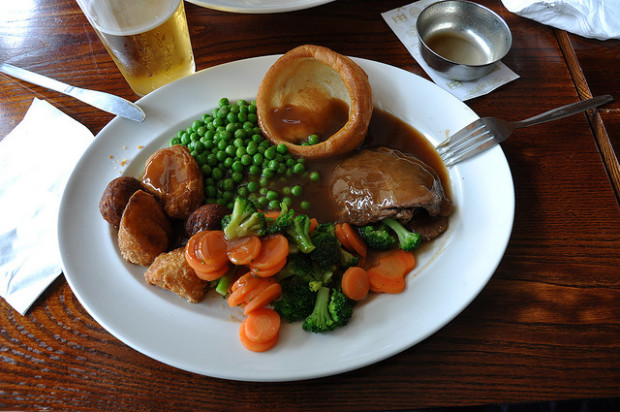You have no items in your cart. Want to get some nice things?
Go shopping
The roast has become a fundamental cornerstone of British culture, but, as with all traditions, it can become tired and neglected through repeated exposure. Happily, in most parts of the country, gone are the days of over-boiled, soggy vegetables, dry centrepieces and lumpy instant gravy – but that doesn’t mean that we wouldn’t all benefit from rethinking what we put on our plate from time to time. For meat eaters, this could mean thinking about locally distinctive, seasonal meats and cuts, moving away from the limited selection presented by supermarkets, and supporting local producers and artisans in the process. It could also mean moving away from meat entirely for at least one weekend a month, and considering the other options are available – such as my delicious vegan haggis. Such a move would certainly fit more accurately in line with the eating habits of the vast majority of British people over the centuries.
The eating of meat at a roast dinner is presented as a tradition of great historical precedence. In fact, however, prior to the Industrial Revolution, the eating of meat was neither financially nor nutritionally viable for great swathes of the British population. At the turn of the eighteenth century for instance, the price of a single chicken would have equated to around one tenth of a cottager’s weekly income [1], rendering the possibility of buying one for the Sunday table all but impossible for just under a quarter of the population [2]. Labouring people and out servants fared slightly better, but only just, and modern research supports contemporary statistician Gregory King’s suggestion that these two classes of people, who constituted over half of the population, had to spend more than they earned [3] (just how they managed remains a mystery). Further to the problem of the price of meat was its distribution: even if a family could afford meat, this did not necessarily mean that they would all have the opportunity to eat it. It certainly wasn’t the most efficient way for most families to get their nutrients [4]. Though working class men and women both commonly worked long hours, [some] men would eat meat daily, while women and children would have to make do without, eating meat perhaps once a week [5]. In some parts of the country they would subsist predominantly on bread and water [6]. As Meredith and Oxley recount: “Women in particular came to rely on the new drug-foods of Empire: tea, sugar, treacle… Although largely empty in calories, these were stimulants, and to an extent appetite suppressants.” [7]
The picture does not necessarily improve that much in the century that follows, the first half of which Professor Burnett describes as “the hungry half century, the period when the diet of the majority of town dwellers was at best stodgy and monotonous, at worst horrendously deficient in quantity and nutriment”[8]. Again, meat was seldom seen, with the Rural Queries (answers to a survey by the Poor Law Commissioners) reporting that meat was eaten in little over half of parishes – and even then only occasionally [9]. As Collins observes: “For the masses, the rising wages in the early to mid-fifties were to a large extent cancelled out by higher meat and bread prices” [10]. In his book The Labouring Classes in Early Industrial England, 1750-1850, John Rule does a fine job of depicting the realities of daily life for Britain’s working classes and takes pains to examine and expose the misuse of patchy statistics that have frequently been employed to gloss over these difficulties. As Rule points out, even when people could afford to buy meat, it was often bought by the pound from unscrupulous shopkeepers and marketeers, renowned for mis-selling produce and landing poor customers in debt [11]. To give a real idea of the quality available, Rule affirms that “food unfit for sale in Liverpool was not unknown to reappear the next day in Manchester”[12].
So, given that little meat was for the most part eaten only infrequently by so much of the British public, where did this hunger for increased meat consumption come from? Well, the answer lies with the Victorians and their taste for rude health and scientific research, as well as changes to agricultural practice. Just as the mineral water of Britain’s spa towns was widely touted for its curative properties, so it was claimed that the consumption of meat — particularly in a cold climate — was important for bodily health, with one famous dietitian in 1871 claiming that it should be eaten three times a day [13]. The association of meat with good health and prosperity led to greater demand for it among these classes, despite any real increase in wages or spending power amongst them [14]. By August 1878, meat consumption was becoming more commonplace, with Richard Jefferies remarking that “at all events, it is certain that butcher’s meat may now be seen in cottages where it never used to be thought of” [15]. In the coming decades, improvements in transport and the continued development of compound feeds brought greater efficiency to livestock farming, which, coupled with the technological advancements of the twentieth century, soon turned into abundance, transforming the hope for better health and prosperity of the working classes into a goldmine, often at the expense of animal welfare. It seems that over time, our relationship with animals raised for meat has changed from one largely of proximity, veneration, and sacrifice, to one of detachment, exploitation, and destruction. It is worth noting that this runs parallel with the Acts of Enclosure and an increased perception of land in purely economic terms – as opposed to conceiving of it as a space in which we can both live and delight.
It is astonishing to think that a country blighted by mortality and morbidity arising from inadequate nutrition for centuries is today fighting an obesity crisis, with roughly 6% of deaths attributable to obesity in the UK today [16] – a figure in no small part linked to increased meat consumption and related risks. The association of meat with prosperity and health has persisted in recent history, reinforced by post-war marketing campaigns that have led to the creation of culinary phenomena such as the English Breakfast and the Ploughman’s Lunch in efforts to shift produce that was no longer rationed [17][18], though these tactics have changed more recently to fit with the agendas of multinational ultra-processed food companies. Though tradition is important and to be celebrated, it is also important that we adapt and innovate according to our individual needs and those of our society. Sometimes it is worth examining the PR myths that lie at the heart of some of our most-beloved institutions, and questioning their true origins.
References:
[1] Laflin, J., ‘The Suffolk Laflins/Laughlins – Their Life & Times’, Lulu.com, 2013, p.41,
[2] York.ac.uk,. N.p., 2015. Web. 20 Oct. 2015.
[3] Hill, Christopher. The Century Of Revolution, 1603-1714 (Routledge. 2012), p.206.
[4] Meredith, David, and Deborah Oxley. ‘Nutrition And Health: 1700-1870’. The Cambridge Economic History Of Britain, ed. Roderick Floud, Jane Humphries and Paul Johnson, 1st ed, (Cambridge University Press, 2011), p.134.
[5] Ibid.
[6] Ibid.
[7] Ibid.
[8] Burnett, John. Plenty And Want (London: Routledge, 1989). Print.
[9] Meredith, David, and Deborah Oxley, p.133.
[10] Collins, E. J. T., ‘Rural and Agricultural Change’. The Agrarian History of England and Wales, Volume 7, Part 1, ed. Joan Thirsk, Edward John T. Collins (Cambridge University Press, 1967), p.110.
[11] Rule, J. ‘The Experience of the Working Class Customer’. The Labouring Classes in Early Industrial England, 1750-1850 (Routledge, 2014), p.63.
[12] Ibid.
[13] Collins, p.110.
[14] Ibid.
[15] Jefferies, R., ‘The Labourer and His Hire’, The Live Stock Journal and Fancier’s Gazette of 30 August 1878, reproduced at https://richardjefferiessociety.co.uk/
[16] noo.org.uk, N.p., 2015. Accessed Oct 20 2015.
[17] O’Connor, Kaori, The English Breakfast (London: Kegan Paul), 2006..
[18] Fast Forward catalogue, London, ICA (1985), p.1978.
Subscribe to Litro Lab via itunes RSS | More

About Concepta Cassar
Concepta is a journalist, forager and food writer, with a particular interest in food anthropology, sustainability, and agricultural affairs. Her recipes have been featured in the Guardian, and she writes for a number of organisations, including BuzzFeed, Aftertastes, and the Soil Association. Her other great loves are literature and modern languages. Concepta speaks French and Italian, and has a working knowledge of Spanish and Russian.






Nice, You have designed the page in such a manner so that one can easily seize information useful to them and also article you have shared is really beneficial.